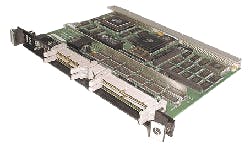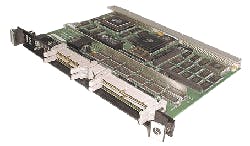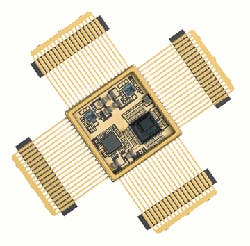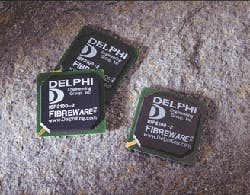NTDS MIL-STD 1553
NTDS MIL-STD 1553
By John McHale
New databus technologies such as Fibre Channel are promising systems integrators super-wide bandwidth that is more than 100 times the speed of the venerable MIL-STD 1397 Navy Tactical Data System (NTDS) and MIL-STD 1553. Many experts say the new commercial technology heralds the end of the old stalwarts.
However, the mighty have not yet fallen — and will not anytime soon, experts say. As evidence, NTDS continues to be on every ship in the U.S. Navy; the cost of retrofitting every ship just to replace NTDS is not a viable option. Neither is replacing embedded 1553 systems that have been in service for as long as 15 years and have little in common with today`s fast serial databus technology.
As another point, companies continue to make a nice living off promoting NTDS and 1553 as viable alternatives to the rapid obsolescence cycles of today`s commercial technology. These companies are keeping NTDS 1553 not just alive, but growing in new applications.
NTDS
"We don`t believe NTDS has passed its prime," says Robert Ruhe, president of GET Engineering Corp. in El Cajon, Calif. GET specializes in making NTDS technology work with today`s COTS technology.
NTDS is still a viable technology with more speed than 1553, running at a bandwidth of 10 megabits per second, says John Lopardo, director of government systems in Sabtech Industries` Virginia Beach, Va., office. The 1553 databus maxes out at 1 megabit per second. In addition, the military`s acquisition and implementation process is too long and complicated to phase out NTDS gracefully and cost effectively, points out Rahim Sabadia, chief executive officer for Sabtech in Yorba Linda, Calif.
"If we wanted to replace all our PCs, we could, with a little luck do it by then end of the day," he says. Yet Sabadia says once an idea is suggested in the military, officials kick it around in a two-year debate, then go through a planning, testing, and implementation process, and end up with a 10-year cycle. In the meantime, equipment and components in development become obsolete, he adds.
The immediate solution would be to buy COTS equipment to get high performance at the lowest cost, Sabadia says. But then the problems begin. First, COTS equipment has a rapid obsolescence cycle. And perhaps more importantly, most old NTDS technology cannot interface with the COTS technology, Sabadia continues. This is where firms like GET and Sabtech enter the arena.
Sabtech engineers focus on redesigning old NTDS boards to interface with new commercially developed software and hardware. Sabadia calls his business MOTS or military-off-the-shelf — mil-spec-grade products available off the shelf.
Navy officials cannot effectively compete NTDS reuse contracts these days because very few companies make these devices anymore; it is not a high-volume business, Sabadia says. "They have to pay for all the research we do," but in the long run they will save money by not having to retrofit an entire ship, Sabadia continues.
Sabtech`s Hawke A/B board is sailing on the aircraft carrier USS John F. Kennedy, Sabadia says. The Hawke A/B board has 16 bits of NTDS available on the VME P2 connector. All boards in the Hawke family feature a 32-bit architecture controlled by an onboard system firmware, which permits simultaneous access to fast RAM, NTDS I/O, and the VMEbus. The Hawke performs NTDS operations through RAM buffers as large as 512 kilobytes, organized as 64K 32-bit words for each I/O channel.
GET engineers continue to develop new interfaces for NTDS to match any new commercial-off-the-shelf program the Navy may employ — PowerPC, VME, Compact-PCI, and now fiber optics, Ruhe says.
GET devices are platform independent, meaning they can go anywhere, Ruhe claims. GET`s products also support the Windows NT and VxWorks operating systems. Naval cadets are working with Windows NT in training so it makes sense to have products ready for them that they are familiar with and can use right away, Ruhe says.
GET engineers are also working on giving NTDS the capability to transmit radar images, says Rod Tuttle, chief technology officer for GET.
Officials of the U.S. Naval Air Warfare Center - Weapons Division at Point Mugu, Calif., recently contracted GET for fiber optic devices for the missile range and test center at Point Mugu. SAIC in San Diego is also involved in the contract.
GET`s fiber optic extender adapters can extend NTDS channels to three kilometers, work with duplex SC or ST fiber optic connectors, have differential/referenced inputs, have short circuit protection, and are available in single or multichannel configurations.
The system converts either one full-duplex parallel channel (type A/B/C/H) or a low level serial (type E) to a fiber optic link at one end and converts it back to the same type NTDS interface at the other end. It supports NTDS data rates.
GET`s NTDS technology is also part of the Naval Surface Warfare Center`s Distributed Command and Control Switching System program in San Diego.
The Federal Aviation Administration (FAA) uses NTDS as well, Tuttle says. During the 1960s FAA officials used many Navy surplus computers for their air traffic control systems, he explains. GET engineers continue to work with FAA officials on their current computer upgrade program.
GET officials also continue to support their original products. Recently the Japanese navy requested 15 new unibus boards, a product GET released in 1983, Tuttle says. GET`s engineers were able to use the old design and build 15 new boards identical to the originals, he says. GET and Sabtech are also part of the U.S. Navy`s Aegis shipboard air-defense program.
Many old military programs do not have the funding to invest in new technology, even for a new version of Sabtech`s Hawke boards, Sabadia says. Sabtech still has customers who use their original board because it is what they can afford, he adds.
MIL-STD 1553
Fibre Channel is the 1-gigabit-per-second data bus that many experts believe represents the future of U.S. military systems networking. Many of these experts believe the rise of Fibre Channel will spell the end of MIL-STD 1553. Yet although the bandwidth of MIL-STD 1553 is limited to 1 megabit per second, some industry experts believe that Fibre Channel can work with and augment 1553.
The 1553 bus is normally for small applications such as handling latitude and longitude data in command and control systems, says Kevin Christian, customer services manager at Ballard Technology in Everett, Wash.
Christian admits there is a need for high-speed data-buses such as Fibre Channel to transfer radar images and large files. Yet he points out that 1553 still has its place. For one thing, MIL-STD 1553 is a standard and companies do not need to spend money to upscreen and certify the technology, Christian says.
MIL-STD 1553 is a necessary requirement for many systems, says Duncan Young, director of marketing at DY 4 Systems Inc. in Kanata, Ontario. It also continues to play a large role in vetronics applications, he says. DY 4 has had its 1553 products on the Army`s M1A2 tanks for years, Young adds. DY 4 also has 1553 products on the Air Force`s B-2 Stealth Bomber.
It would have to be a very large endeavor on behalf of the military to completely replace all their 1553 systems, says Carl Leary, Midwestern sales manager for VMIC in Huntsville, Ala. An entire plane or ship may have to be retrofitted just to pull out all the cabling, he explains. It would be too expensive for them to do, Leary adds.
The NASA Space Shuttle was designed before the 1553 standard was finalized and is based on an earlier version of the specification, "but NASA is not going to tear apart the space shuttle design to put in 1553 let alone Fibre Channel," Christian says. It is not cost-effective, he points out.
Another problem with replacing all 1553 with Fibre Channel is software compatibility, says George Meares, vice president of research and development at VMIC. Currently there are neither Fibre Channel devices designed to work with the Ada programming language,, nor is there any interest, he adds.
Maybe in 20 years 1553 will go away, but not any time soon, says Gorky Chin, vice president of advanced technology at Vista Controls Corp. in Santa Clarita, Calif. Fibre Channel is mostly going into new designs and retrofits, he says.
When there is no need for high speed, designers will most likely stick to 1553, Chin adds. Chin`s company is still hedging its bets and offering alternative products to 1553.
Vista`s Fibre Channel PCI Mezzanine Card (PMC) is a 102.7 megabit-per-second Fibre Channel interface with redundant connectivity via an integrated network hub. Vista officials are reselling the PMC card design of Delphi Engineering in Costa Mesa, Calif. Vista engineers are also working on a conduction-cooled version of the device.
Vista engineers offer a Fibre Distributed Data Interface (FDDI) PMC for the military and high-reliability markets. The device is a dual attached FDDI adapter designed for embedded applications.
FDDI, a 100-megabit-per-second data bus, is a definite standard with dual redundancy and fault tolerance listed right in the specifications, Chin says. While Fibre Channel may have both attributes, it does not a guarantee them both, he explains.
However, FDDI is slowly fading away, and many companies are doing lifetime buys of their FDDI products, claims Jack Staub, president of Delphi. One of the reasons for its departure is that it does not have the horsepower to compete with Fibre Channel and other high-speed databuses, Staub explains. The 1553 bus, however, is not fading away just yet, Staub says, but will always have a niche in legacy systems.
Military designers will not tear out 1553 just to put in Fibre Channel, says Michael Hegarty of Data Device Corp. (DDC) in Bohemia, N.Y. It is not practical, he adds. Fibre Channel and 1553 can work together, Hegarty adds.
Currently DDC`s mini ace 1553 product and DY 4`s Channel One PMC card are in the same box for the mission processor on the Air Force`s F/A-18 fighter-bomber avionics upgrade. Most mission processors have several 1553 buses and one Fibre Channel device, he says. DDC`s MIL-STD-1553 Mini Ace/Mini Ace Plus card is an integrated, 5 volt, with MIL-STD-1553 A/B STANAG 3838 compliant terminals.
DY 4`s high-speed Fibre Channel network interface PMC card is a dual-port, 1.0625-gigabit-per-second card that provides an interface between compute elements and Fibre Channel networks. It supports arbitrated loop, point-to-point, and switched fabric topologies and is compatible with DY 4`s PowerPC, Pentium, and digital-signal-processing-based motherboards. The PMC-642 also uses the industry standard Virtual Interface Architecture as a standard programming interface. DDC provided the ASICs for the device.
Fibre Channel and 1553 have their differences. The two have fundamentally different topologies — Fibre Channel is a hub and 1553 is a linear bus, Hegarty explains. In addition, the 1553 can run data throughout an aircraft, while Fibre Channel may not, points out Anthony Jordan, product line manager for UTMC Microelectronics Systems in Colorado Springs, Colo. Using Fibre Channel to route data throughout an entire airframe may leave the bus susceptible to electronic interference — or may itself cause interference, Jordan says.
UTMC engineers offer their Summit RTE device for 1553 applications. The device is a dual-redundant 1553 remote terminal with integrated bus transceivers, and memory offered in a flatpack.
Currently UTMC officials are looking to get their 1553 products in the collision avoidance systems for the Air Force`s C-5 and C-130 cargo aircraft upgrade programs, Jordan says.
VMIC`s Meares says he believes that shipboard platforms will most likely be the first ones to totally embrace Fibre Channel because of the need to send radar images and other signals at high data rates.
VMIC engineers have their VMICVME-6000 1553 single-board computer flying in the U.S. Air Force`s B-1 bomber avionics suite, Leary says. The VMIC device has an ASCI-based design. Its configurations are in bus controller, bus simulator, multiple remote terminal/monitor, bus analyzer, and diagnostic. It has 256 kilobytes of dual-port memory and error detection, as well as detailed error reporting.
VMIC products are for simulations. Whether or not the customer will want a 1553 product or Fibre Channel depends on what the aircraft uses, Leary says.
Modular avionics is where Fibre Channel will fit best, Hegarty says. In modular avionics, data such as radar imagery converts to digital, runs through a processor, then outputs to multifunction or heads-up displays, he explains. Fibre Channel`s high bandwidth works well for that approach, Hegarty says.
The 1553 databus, meanwhile, is becoming easier and less expensive to implement than in the past, Christian says. In fact many satellites are now using 1553 because it is robust and uses message-by- message error checking, he notes. However the error checking does take a lot of time, Christian cautions.
DDC`s Hegarty says he also sees 1553 expanding in the munitions market.
Other industries are also finding uses for 1553 such as oil drilling, nuclear power plants, and water treatment facilities, Christian says. MIL-STD 1553 is here to stay for quite some time, he adds.
Ballard engineers are working on a stand-alone universal serial bus box that can interface with 1553, Ethernet, or other databuses for avionics test equipment, Christian says. "1553 is by no means dead yet, DY 4`s Young says. "It will have a part to play for the next five or ten years along side Fibre Channel, of course"
1553 offerings
Experts at Condor Engineering in Santa Barbara, Calif., offer a single-bus, multifunction, MIL-STD-1553 PMC Module. The device has a simultaneous bus controller, 31 remote terminals, bus monitor modes, one megabyte of RAM, error injection/detection, and I/O triggering. It also includes high-level 1553 application programming interface libraries for Windows NT, 98, 95, LabWindows/CVI, and Visual Basic. It is also available with rear connector I/O.
Engineers at Systran in Dayton, Ohio, offer the BusXchange Multiplex Bus Switch, which provides a "virtual patch panel" in a 19-inch rack-mountable chassis. BusXchange eliminates time-consuming bus rewiring between different avionics simulations or test scenarios. This 16-by-16 crosspoint switch provides differential connections from 16 transformer-coupled line replaceable unit (LRU) inputs to 16 MIL-STD-1553 differential buses. LRUs can be any MIL-STD-1553 device, bus controller, remote terminal, or bus monitor.
Ballard Technology engineers have developed the LC1553-3x, a family of dual-redundant MIL-STD-1553 interface boards for CompactPCI computers. This family of products provides capabilities from basic single-terminal emulation to multi-terminal simulation and error injection.
Engineers at SBS Technologies Avionics Products in Albuquerque, N.M., offer the ABI-1553 device ABI-PCM2. The ABI-1553 interface provides flexible, full-function or single-function MIL-STD 1553 interfaces to PCMCIA systems. The ABI-PCM2 provides concurrent and independent operation of a bus controller.
The onset of high-speed commercial-grade serial databuses have led to industry predictions of the slow death of MIL-STD 1397 and 1553, yet many companies not only still produce their original designs but continue to thrive off new products based on the decades-old standards
The miniace 1553 device from data Device Corp. (above) and the Channel One PMC card from DY 4 Systems (at left) are part of the U.S. Air Force F-18 avionics upgrade. (Previous page: the Sabtech IndustriesA/B NTDS board is steaming aboard the aircraft carrier USS John F. Kennedy.)
Delphi creates new Fibre Channel company
Officials at Delphi Engineering in Costa Mesa, Calif., have branched off their Fibre Channel business into a separate company called FibreGear.
FibreGear will focus on developing and applying Fibre Channel technology to real-time embedded systems, says Jack Staub, president of Delphi Engineering. FibreGear experts develop and manufacture Fibre Channel interface cards for standard industrial form factors such as PCI, PMC, and CompactPCI.
FibreGear also offers Fibre Channel controllers upscreened to full industrial and military temperature ranges. Experts at QLogic in Costa Mesa, Calif., provided the controllers to Delphi.
"We`ve reached acceptable yields" on the military-temperature controllers, Staub says, but will not make a product "until we have a customer." The military-temperature range is -55 to 125 degrees Celsius.
Delphi`s industrial-temperature product, the DEG-2100A is already on the market and flying in military applications. It is part of the F/A-18 avionics upgrade, the U.S. Army`s Firefinder TPQ47 ground-based radar, and the Navy`s Virginia-class new attack submarine, Staub says.
Delphi officials are also looking to replace all the 1553 on the Army AH-64 Apache Longbow attack helicopter avionics upgrade with Fibre Channel. Boeing in Seattle is the prime contractor for the upgrade.
The device has a temperature range of -45 to 85 degrees C, supports 100 megabits per second sustained Fibre Channel data transfer rate, and has a 33-MHz, 64-bit PCI Host Bus Interface.
The DEG-2100A is a single-chip, integrated, bus master, Fibre Channel processor that targets SCSI and communication applications. This chip connects the PCI bus to a Fibre Channel loop and contains an on-board RISC processor. The device is a fully autonomous, capable of managing multiple I/O operations and associated data transfers from start to finish without host intervention.
The company`s I/O link product enables simple I/O devices such as A-D converters, D-A converters, and video devices to be connected directly. The I/O link module supports continuous data transfer rates, which exceed 100 megabits per second, with transfer latencies as low as 30 microseconds, Delphi officials say.
FibreGear supports various real-time operating systems such as VxWorks and LynxOS, as well as standard operating systems such as Windows NT, Solaris, and Linux. A source code license and supporting engineering services are also available for custom solutions.
FibreGear products are also embedded into air, sea and land-based real time systems, for high bandwidth storage transmission and storage of radar, sonar and signal intelligence data.
For more information on FibreGear contact the company by phone at 949-515-1490, by fax at 949-515-1491, by mail at FibreGear, 485 East 17th Street, Suite 400, Costa Mesa, Calif. 92627, or on the World Wide Web at http://www.fibregear.com. — J.M.
The DEG-2100A industrial-temperature Fibre Channel interface card from Delphi Engineering is part of the U.S. Navy`s Virginia-class new attack submarine.
Raytheon uses Cabletron`s SmartSwitch Router for NASA`s Internet Exchange
Engineers at Raytheon Systems Co. in Lexington, Mass., are using the SmartSwitch Router (SSR) from Cabletron in Rochester, N.H., for NASA`s next-generation Internet Exchange.
Experts at NASA Ames Research facility in Mountain View, Calif., are "currently researching and designing the next-generation Internet Exchange," says Lance Tatman, network engineer for Raytheon Systems Co. "For a project of this magnitude, we need wire-speed switching performance to support uplinks to the Internet backbone. We`ve been looking at Cabletron`s SmartSwitch Routers for some time now, and with new Packet-over-SONET and ATM [Asynchronous Transfer Mode] interfaces, it is certainly a viable solution for the rigorous demands of our environment.
"We have already placed the SSR into operation on the MAE-West Ames, one of the West Coast`s busiest Internet Exchange Points, and can now offer Exchange point connections at gigabit data rates," Tatman continues.
Cabletron`s new modules extend the SmartSwitch Router`s wire-speed routing and QoS capabilities at OC-3c and OC-12c speeds, while POS and ATM interfaces further extend the [SmartSwitch Router`s] WAN connectivity in service provider, large enterprise, and government environments.
The new ATM modules deliver wire-speed access for T1/E1, T3/E3, and OC-3c connections. Extensive QoS, traffic shaping, and VC support provide service providers ATM connectivity at the subscriber edge to provision ATM-based services to corporate clients. POS OC-3c and OC-12c modules provide advanced hardware routing, QoS and redundancy features that enable high-speed uplinks to backbones. Local switch routing, in conjunction with WRED on the POS modules, provide strong performance and functionality.
"Cabletron`s SmartSwitch Router is a feature-rich, cost-effective solution for government and service provider environments that demand wire-speed performance at a reasonable price," explains Ed Chang, Cabletron`s director of SmartSwitch Router products. "Our SSR solution is the only Layer-3 switch currently shipping with WAN interfaces. And with the addition of these new ATM and POS interfaces, it easily meets the high speed WAN needs of service providers."
Cabletron`s ATM OC-3c modules will be available for the SmartSwitch Router 2000, 8000, and 8600 chassis this month, starting at less than $10,000. Cabletron`s Packet-over-SONET modules will be available for the SmartSwitch Router 8000 and 8600 chassis also this month. POS OC-3c modules will start at under $30,000, and OC-12c modules will start at under $40,000.
For more information on the SmartSwitch Routers contact Cabletron by phone at 603-332-9400, by mail at Cabletron Systems, 35 Industrial Way, Rochester, N.H. 03867, by email at [email protected], or on the World Wide Web at http://www.cabletron.com. — J.M.
Who`s Who among NTDS and 1553
NTDS
GET Engineering Corp.
El Cajon, Calif.
619-443-8295
www.getntds.com
Sabtech Industries
Yorba Linda, Calif.
714-692-3800
www.sabtech.com
MIL-STD 1553
Ballard Technology
Everett, Wash.
425-339-0281
www.ballardtech.com
Condor Engineering
Santa Barbara, Calif.
805-965-8000
www.condoreng.com
Data Device Corp.
Bohemia, N.Y.
516-567-5600
www.ddc-web.com
DY 4 Systems
Kanata, Ontario
613-599-9199
www.condoreng.com
SBS Technologies
Albuquerque, N.M.
505-875-0600
www.sbs.com
Systran Corp.
Dayton, Ohio
937-252-5601
www.systran.com
UTMC Microelectronics Systems
Colorado Springs, Col.
719-594-5500
www.utmc.com
VMIC
Huntsville, Ala.
256-880-0444
www.vmic.com





